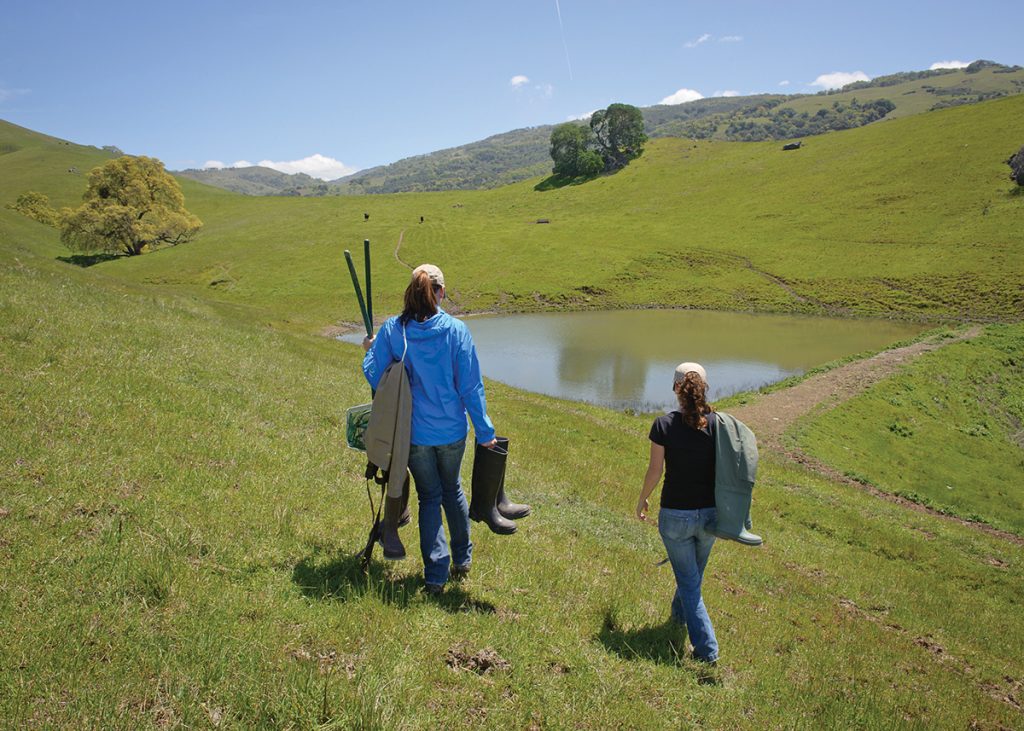
Resource conservationists prepare to survey wildlife in a livestock pond in Eastern Alameda County. Photo courtesy the Natural Resources Conservation Service.
When ecologist Jackie Charbonneau learned that cattle ponds in the East Bay hills are vital to rare amphibians, it came as a surprise. Stock ponds can be so muddy and trampled that “they can look like a bomb hit them,” said Charbonneau, who works in Alameda County at the U.S. Department of Agriculture’s Natural Resource Conservation Service. But looks can be deceiving. As an East Bay Regional Park District intern early in her career, she found that stock ponds are full of California red-legged frogs and California tiger salamanders, which are unique to the state and federally listed as threatened.
“I thought, ‘Holy cow, this is amazing,’” Charbonneau recalled. But the stock ponds dotting East Bay rangelands are in trouble. Most were built so long ago — about half a century — that they are eroded and choked with silt. Today Charbonneau is part of a multi-agency team that restores these unconventional wildlife habitats. Other partners include the Alameda County Resource Conservation District and the U.S. Fish and Wildlife Service.
Red-legged frogs are the largest native frogs in the western U.S., at up to three inches for tadpoles and five inches for adults. Named for their vivid red hind legs, these otherwise well-camouflaged frogs breed in still, deep waters between January and March. When summer comes, they go dormant in cool, moist spots like leaf litter or ground squirrel burrows. Before that, the mostly nocturnal adults eat anything from insects to smaller frogs and even mice. In turn, red-legged frogs are eaten by herons, garter snakes, and foxes, to name just a few of their predators. Worst of all is the American bullfrog, which was introduced from the East Coast during the Gold Rush for people to eat. Bullfrogs gobble red-legged frog tadpoles and froglets, wiping out entire populations from breeding pools.
California tiger salamanders, about eight inches long with striking yellow spots against shiny black skin, would stand out if they didn’t spend most of their lives hidden. Like red-legged frogs, adult tiger salamanders shelter in burrows during the summer. These insect-eating amphibians typically emerge to breed on a stormy November night, trekking as far as one mile in search of a pond. Tiger salamanders can live 10 years but don’t mate until they are four to five years old. Many don’t mate at all. Birds, fish, and bullfrogs pick them off, cars squash them as they cross roads, and the vernal pools and seasonal ponds where they breed vanish during droughts.
The biggest threat to California’s red-legged frogs and tiger salamanders, however, is habitat loss to urban development and farming. And that’s where rangeland stock ponds come in. “They’re oases for wildlife,” Charbonneau said. In addition to amphibians, the ponds sustain a diversity of animals from bats to mountain lions.
To protect the stock ponds that red-legged frogs and tiger salamanders rely on, in 2005 Charbonneau helped launch the Wildlife-friendly Pond Restoration Program. Alameda County has about 700 stock ponds scattered across its rangeland, about 200,000 acres or two-fifths of the county’s area. “The program stemmed from requests from ranchers,” Charbonneau said.
Darrel Sweet was one of the first ranchers to participate in the Wildlife-friendly Pond Restoration Program. His family has operated a cattle ranch in the Altamont Hills near Livermore since the 1860s, and today their thousand acres are stocked with about 100 Angus cows, an even-tempered black breed that naturally lacks horns. Ranching all those cows takes a tremendous amount of water. “They weigh 1,200 or 1,300 pounds,” he explained. “A cow will drink 25 gallons of water on a hot day.”
One of Sweet’s stock ponds was built around a spring in 1966 and was about to fail. “The whole dam was about to go down the canyon,” he said. But fixing it on his own was daunting because projects involving listed species require permits from regulatory agencies. “Ranchers used to think, ‘Oh my god, I hope they don’t find red-legged frogs on my land,’” he said.
Cost is another hurdle to fixing stock ponds. It took about $35,000 to dredge out his pond — which is about 10 feet deep with a footprint the size of a house — and then retrofit the dam and spillway to government engineering standards. Depending on the size and surrounding terrain, pond restorations can run as high as $200,000.
The Wildlife-friendly Pond Restoration Program offers ranchers cost-share funding as well as technical assistance in meeting engineering standards. The program also streamlines the permitting process, which can shorten the approval wait time from about a year to two months. So far, NRCS has dedicated about $650,000 to the program, which has restored more than 40 Alameda County stock ponds.
Even with the cost-share provision, ranchers still face substantial out-of-pocket expenses. Avra Heller of the State Coastal Conservancy manages another wildlife-friendly pond restoration program that also covers the ranchers’ share of costs in Alameda and Contra Costa counties. This program offers nearly $500,000 in competitive grants funded by Proposition 1 — the Water Quality, Supply, and Infrastructure Improvement Act of 2014 — and requires grantees to maintain their projects for 20 years by performing upkeep activities such as fixing stock pond leaks. Moreover, the program funds trough installation in addition to stock pond restoration. Piping water from a spring to a trough can help protect critical habitat for red-legged frogs, tiger salamanders, and other wildlife. “Riparian areas can be small and delicate on ranches, and troughs can get cattle off sensitive creeks,” Heller said.
Climate change is projected to intensify droughts and increase the number of extreme heat days, adding urgency to stock pond restoration. Already, these ponds can disappear during dry years. During the most recent drought — the worst in California’s recorded history — ranchers reported stock ponds drying up so early that red-legged frog tadpoles and tiger salamander larvae didn’t have time to metamorphose into adults. Dredging out sediment deepens ponds, boosting their storage capacity so they stay wet longer into the year.
Sweet feels gratified in supporting the natural world. He remembers finding tiger salamanders in livestock ponds on his family’s ranch as a child, and more recently spotted a red-legged frog in his restored pond with his five-year-old granddaughter. “We enjoy showing people the frogs on our ranch in the spring,” he said. “These conservation projects keep us relevant and make ranching more valuable.”
Robin Meadows covers water for the Monitor.

